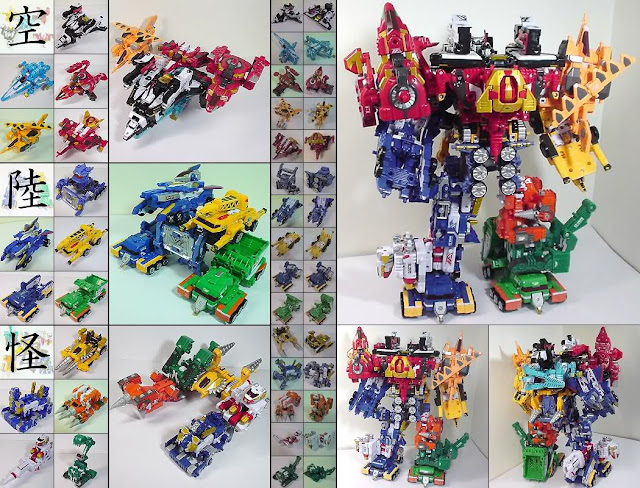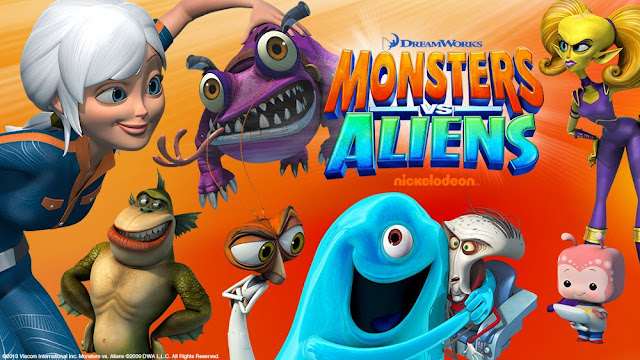Machine Robo's Magnificent Robot Combiners
I don't collect Transformers merchandise, but I see articles and advertisements about it when I browse through Japanese robot toy sites. From what I can gather, one of the latest product lines for Transformers is called "Combiner Wars", a line that consists of five or six transforming robot toys that combine into one bigger robot.
Combiner robot toys have been around for a long time, and Transformers had quite a few of them even back in the '80s. Yet of the many combiner robot toys I've seen over the years, the ones that have consistently impressed me were the ones released by Bandai under the Machine Robo line. Whereas other robot toy lines are stuck in the novelty of combining smaller toys into a bigger toy, Machine Robo has used the concept of combination to promote creative play. Read on for a review of how Machine Robo has built upon its combiner toys throughout the years.
Even though combining robots have been around in Japanese pop culture since the '70s, it didn't take off in the U.S. until the '80s when the Voltron cartoon series and toy line arrived. Voltron, which was cobbled together from Armored Fleet Dairugger XV and Beast King GoLion anime series and their respective merchandise, featured giant robots that were assembled from smaller robots or vehicles. Transformers jumped on this combiner bandwagon soon afterwards, with giant robot toys that were assembled from smaller transforming toys.
The Voltron cominber robot toys from the '80s
Being a child of the '80s, I had some of the Voltron and Transformer combiner toys. The Voltron toys were fairly sturdy, but the Transformer combiner I bought--the Devastator set--was a major letdown. The Devastator robot was made up of six smaller robots that transformed into construction vehicles. However, the set required a significant number of extra parts in addition to the smaller robots to complete the Devastator configuration; if any of the extra parts were lost, Devastator would wind up missing its legs, arms or head. Furthermore, Devastator itself could barely stand on its own and featured very few moving parts, revealing just how poorly designed the whole thing was. The Transformers line might have been a giant among robot toys in the '80s, but its Devastator set wasn't worth the price.
The Transformer's Devastator set, which excelled at devastating collector expectations.
On the other hand, there was Machine Robo. It was repackaged as the Gobots line in the U.S. by Tonka and even though it is still considered by some to be the inferior version of the Transformers, Machine Robo toys were much more durable, cheaper in price, and its combiner sets could stand on their own and didn't require extra parts to complete.
Machine Robo's Machine Puzzler combiner set, no extra parts required.
The coolest Machine Robo combiner set was "Devil Satan 6", which was re-named to "Monsterous" for its U.S. release. I've been tempted to pick this one up for myself just so I can say that I own something called "Devil Satan 6".
The Devil Satan 6 set.
When the Machine Robo came back in 2003, it came back with two combiner-based lines: Machine Robo Rescue (which had its own anime series) and Machine Robo Mugenbine.
The MRR line consisted of several rescue vehicle-themed combiner sets. Each set came with a lead robot figure (some of which were based on figures from the original Machine Robo series from the '80s) and four identical drones. The lead robot and its drones could transform into vehicles and combine to form a larger robot. However, unlike all other combiner robot toys, the MRR sets were designed in such a way that kids who own more than one set could combine the robots and drones together into even larger combinations.
Above: Two different MRR combiner sets.
Below: Multiple MRR combiner sets assembled into a single robot.
Another cool set of toys from the MRR line were the transport sets, which could contain smaller MRR figures (i.e., to transport the MRR combiner teams into battle). The transport sets could also be reconfigured into larger combiner robots, which meant that combiner robots could be stored inside of even larger combiner robots. It's like Russian nesting dolls but with a transforming and combining Japanese robot spin.
Two MRR transport sets, each in combiner mode.
In contrast to the MRR line was the Mugenbine line, which took the concept of transforming and combining robot toys to a whole new level. According to Wikipedia, "Mugenbine is a term derived from the words 'mugen', which is Japanese for 'infinite', and the English word 'combine', which is the theme for the series. Rather than the traditional shape changing method of previous figures, Mugenbine uses numerous interlocking pegs and sockets to attach and remove components and relocate them in order to form different modes. While all figures have at least two official alternate modes and most have official combinations with one to three other figures, the concept of the line is to allow you to assemble your own animal and machine creations and build your own robots of various size and numbers of sets, an activity encouraged by Bandai to the point where figures with no official combiner modes come with larger head parts to help create your own."
A Mugenbine figure box,
Because the Mugenbine line didn't feature any specific combiner sets, kids and collectors could combine the Mugenbine toys into arrangements of any size and shape. Below are some example of how creative kids and collectors got with the Mugenbine line.
Transforming and combining robot toys aren't typically thought of as toys that promote creative thinking, but the MRR and Mugenbine lines serve as the exceptions to that rule. Many fans still wax nostalgic for Habro's Transformers, but I think that Bandai's Machine Robo lines were the one that proved the full potential of robot toys.
















Comments
Post a Comment